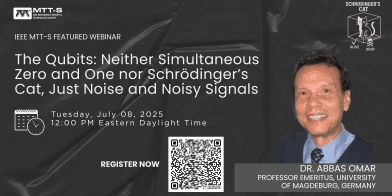
-
Tuesday, July 08, 2025 12:00 pm - 1:00 pm(New York Time) Add to my calendar
The Qubits: Neither Simultaneous Zero and One nor Schrödinger’s Cat, Just Noise and Noisy Signals
Dr. Abbas Omar
Professor emeritus, University of Magdeburg, Germany
Abstract:
Most publications on quantum computing and its main building block—the qubit—rely on quantum theory and use its terminology. It is therefore not an easy task for electrical engineers to fully understand the concept of qubits and how they are designed, controlled, read out, and used for computation.
The primary aim of this paper is to show that the physical quantities describing superconducting transmons—the most commonly used microwave realizations of qubits—are simply noisy signals, similar to those encountered in, for example, mobile and satellite communications. The nature of the noise in the case of qubits, which will be simply called quantum noise, is essentially different from that of, for example, thermal noise. Contrary to the well-studied thermal noise, quantum noise follows precise probability distributions and can interfere coherently. In particular, the so-called stationary states resemble individually pure noise. However, a superposition of at least two of them results in a noisy signal whose signal-to-noise ratio improves (increases) as more stationary states enter the superposition.
Furthermore, the excitation (control) and readout of qubits will be treated from the perspective of electrical engineering.
Speaker’s Bio:
Dr. Omar is a Professor Emeritus at the Otto von Guericke University of Magdeburg in Germany. He received his B.Sc., M.Sc., and Doktor-Ing. degrees in electrical engineering in 1978, 1982, and 1986, respectively. He has been a professor of electrical engineering since 1990 and served as the Director of the Chair of Microwave and Communication Engineering at the Otto von Guericke University of Magdeburg, Germany, from 1998 until his retirement in 2020.
He joined the Petroleum Institute in Abu Dhabi as a Distinguished Professor in 2012 and 2013, where he organized research activities for the oil and gas industry in the region. In 2014 and 2015, he chaired the Department of Electrical and Computer Engineering at the University of Akron, Ohio, USA.
Dr. Omar has authored and co-authored more than 490 technical papers spanning a wide spectrum of research areas. His current research and teaching interests include quantum computing, the health aspects of millimeter-wave radiation, phased arrays and beamforming for massive MIMO, and magnetic resonance imaging.
In the past, he has also contributed to various other disciplines, including microwave and acoustic imaging, microwave and millimeter-wave material characterization, indoor positioning, subsurface tomography and ground-penetrating radar, as well as field-theoretical modeling of microwave systems and components.
Dr. Omar is a Life Fellow of the IEEE.